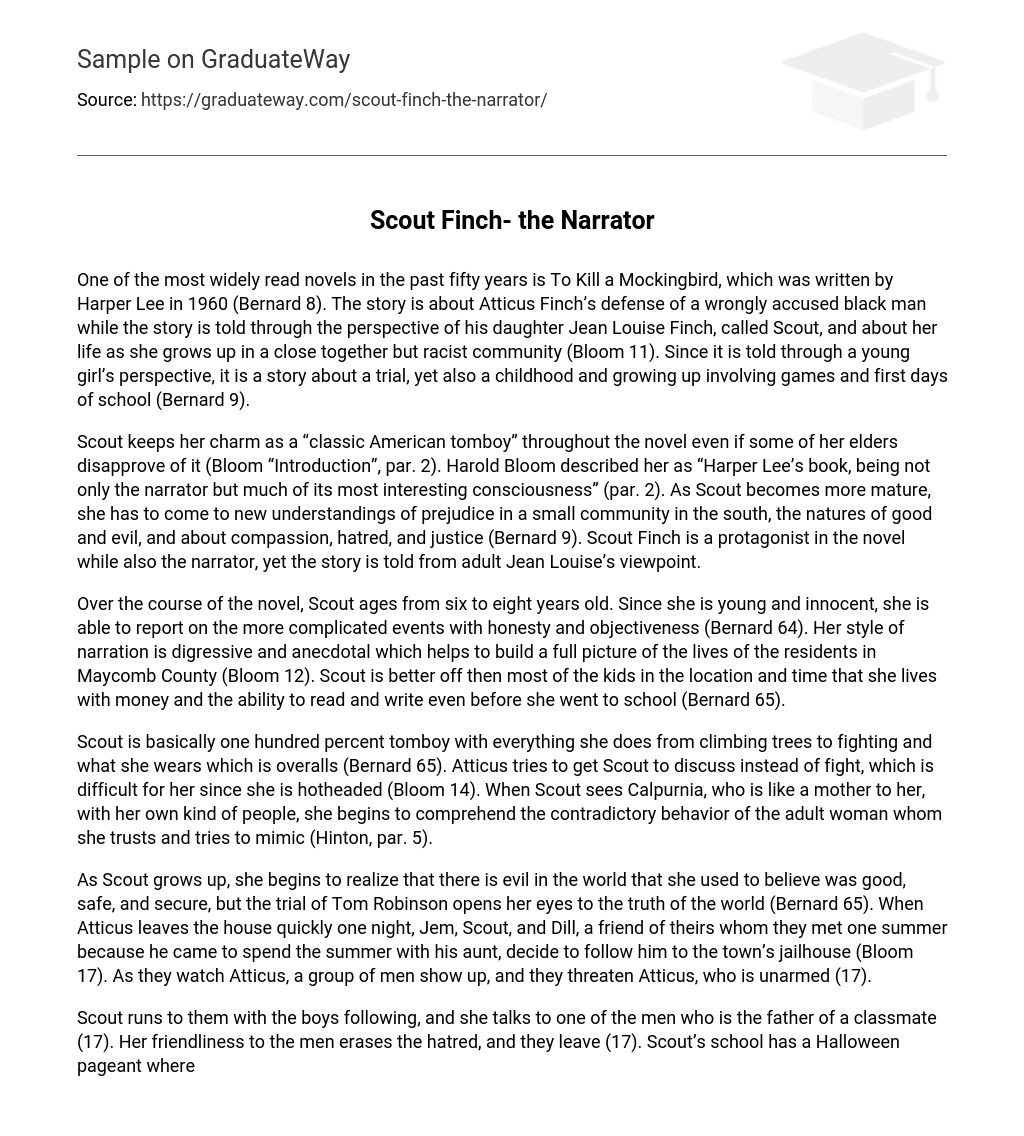One of the most widely read novels in the past fifty years is To Kill a Mockingbird, written by Harper Lee in 1960 (Bernard 8). The novel revolves around Atticus Finch defending a falsely accused black man. It is narrated from the perspective of his daughter, Jean Louise Finch (Scout), as she grows up in a racially divided community (Bloom 11). Although primarily a trial story, it also explores Scout’s childhood experiences, including games and her first days of school (Bernard 9).
Throughout the novel, Scout maintains her charm as a “classic American tomboy” despite disapproval from some of her elders (Bloom “Introduction”, par. 2). Harold Bloom describes Scout as the narrator and the source of the most captivating consciousness in Harper Lee’s book (par. 2). As Scout grows older, she must grapple with new understandings of prejudice in a small Southern community, the complexities of good and evil, and concepts like compassion, hatred, and justice (Bernard 9). Scout Finch serves as both the protagonist and the narrator of the novel, but the story is told from the perspective of the adult Jean Louise.
During the course of the novel, Scout undergoes a two-year transformation from the age of six to eight. Due to her youth and innocence, she is able to provide honest and objective accounts of the complex events she witnesses (Bernard 64). Scout’s narration style is tangential and anecdotal, allowing for a comprehensive understanding of the lives of Maycomb County residents (Bloom 12). Additionally, Scout enjoys more privileges than most children in her community, such as access to education and literacy skills even before attending school (Bernard 65).
Scout is completely tomboyish in every aspect of her life, including her activities such as tree climbing and fighting, as well as her choice of clothing – overalls (Bernard 65). Despite being hot-headed, Atticus attempts to encourage Scout to engage in discussions rather than resorting to physical fights (Bloom 14). On witnessing Calpurnia, who serves as a mother figure to Scout, associating with people from her own community, Scout starts to grasp the conflicting behavior of this trusted adult woman whom she looks up to and tries to imitate (Hinton, par. 5).
Scout’s realization of the presence of evil in the once believed good and secure world occurs as she witnesses the trial of Tom Robinson, as stated by Bernard (65). The decision to follow Atticus to the town’s jailhouse is made by Jem, Scout, and their summer acquaintance Dill, when Atticus leaves their house abruptly one night. According to Bloom (17), a group of men confront Atticus while he is unarmed, adding to the revelation experienced by Scout.
Scout swiftly approaches the men, with the boys trailing behind. She engages in conversation with one of the men, who is a classmate’s father (17). By displaying affability towards the men, Scout manages to dissipate the animosity, leading to their departure (17). At Scout’s school, a Halloween pageant takes place, in which she assumes the role of a ham (Bernard 55). Subsequent to the conclusion of the pageant, Jem and Scout make their way back home (55). However, during their journey, they fall victim to an attack. Fortunately, someone intervenes and rescues Scout, while Jem is carried home, where they discover his broken arm. The assailant is revealed to be Bob Ewell, who met his demise by being fatally stabbed. It is at this point that Scout realizes Boo Radley is her savior (55).
Scout, who is no longer afraid of Boo, accompanies him back to his house. On the porch, Scout learns the lesson that her father had tried to impart to her: not to judge others and to try to understand their perspective (Bloom 21). Aunt Alexandra’s prejudice leads Scout to feel distressed when she is forbidden from inviting a less fortunate white classmate over (Bloom 20). When Dill flees from his own home, he teaches Scout the importance of appreciating her family, regardless of any hardships they may face (Bloom 16).
Despite the evil witnessed by Scout, she maintains her idealism and faith in the integrity of the people of Maycomb County (Bloom, par. 2). Although Scout recognizes that society’s prejudices are confusing and aggravating, they still have a strong influence on the residents of Maycomb County, with some individuals even being destroyed by this influence (Bernard 78). The novel is narrated by Jean Louise during her ninth year and focuses on the events surrounding Bob Ewell and Boo Radley, and how these events impact Jem, Atticus, and Scout’s life (Bloom, par. ). Throughout the story, Scout grapples with the meaning of her father’s actions during a time when white superiority is believed to be true (Bernard 8). According to Bloom, Scout has an exemplary father in Atticus, an exceptional brother in Jem, and her own attitude is so wholesome that it charms nearly everyone she encounters (par. 4). From Tom Robinson’s trial, Scout learns that prejudice clouds moral judgment, while also discovering that courage and belief can be powerful weapons against racial prejudice (Bloom 22).





